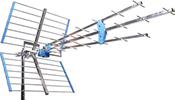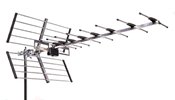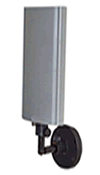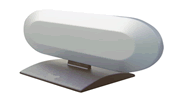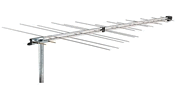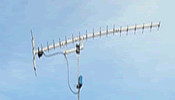Identification and characterisation of TV aerials to receive DTT in Portugal
In Portugal, there is a wide of range of products available on the market for aerials designed to receive Digital Terrestrial Television signals and some manufacturers have even brought out aerials specifically designed for DTT reception. Given the apparent difficulties in choosing the right aerial, the best way to ensure good reception is to use an aerial for the whole UHF band, with a gain that is high enough in terms of the respective installation, making sure that it is properly pointed towards the DTT transmitter that best serves the location. Depending on the type of coverage in the location where reception is required, reception can be provided using exterior aerials or indoor mobile aerials.
Some examples are given below of aerials suited to receive DTT, including some important characteristics (however this description is not exhaustive in terms of all the options available on the market).
Types of DTT aerials
The description that follows is intended to help anyone who is not sure about the types of aerial which can be used to receive DTT as a replacement or new installation. There are many manufacturers and models, and only some of the types of aerial available on the market are covered here. These have been selected as examples, with electrical and mechanical characteristics which are suitable for DTT signal reception in Portugal.
As such, besides the quality of manufacture, the main characteristics to be taken into account are:
- The aerial’s gain in the UHF band, especially with respect to channels 60 to 67 and according to the needs of the installed or planned network;
- Cost/benefit;
- Visual impact.
Examples of aerials suitable for DTT reception
Example 1 – Outside Yagi Aerial with three elements
Characteristics
- Aerial suited for digital terrestrial TV reception
- Typical channel 21 to 69 bandwidth– Banda UHF
- 3 element angular array, makes it directional and wideband.
Example 2 – Outside Yagi Aerial with one element
Characteristics
- Aerial suited for digital terrestrial TV reception
- Typical channel 21 to 69 bandwidth– Banda UHF
- Only 1 element, with a typically slightly lower gain, but cheaper than the 3 element aerial shown in example 1.
Example 3 –Flat Outside Aerial
Characteristics
- Aerial suited for digital terrestrial TV reception
- Typical bandwidth between channels 5 to 12 (VHF) and channels 21 to 69 (UHF)
- Aerial with less of a visual impact, but because it is an active aerial (with amplification), it needs to be plugged into the electricity mains.
Example 4 –Flat Indoor Aerial
Characteristics
- Indoor aerial which can be used to receive digital terrestrial TV in zones were portable indoor reception is possible.
-
Typical bandwidth between channels 5 to 12 (VHF) and channels 21 to 69 (UHF)
Aerials which are already installed
If you have an MATV system already installed and wish to check whether it is suitable for receiving DTT, you should first of all check the following:
- Type of aerial installed (must be appropriate for UHF or MIXED operating frequencies);
- Pointing of transmitter (should be chosen according to best signal);
- State of repair (corroded or rusty diploes could inhibit reception).
In terms of the type of the aerial installed and its general use, log-periodic antenna (shown below) are mixed aerials, in that they operate simultaneously in the UHF and VHF band, with lower gain than aerials of the Yagi type (UHF band, see examples 1 and 2), and as such do not guarantee proper reception of the DTT service in all cases. Suitability for use should therefore be checked.
Figure - log-periodic antenna
Older models of Yagi aerial are still in use suited for digital terrestrial TV reception, with vertical reflector elements having many directional elements. Despite its lower market demand, the picture shown below was left in the manufacturer's catalogue.
Figure - Antena Yagi com reflectores na vertical e elevado número de elementos directores
It should be noted however, that in certain areas of the country, the operator authorised to provide the DTT service (PT Comunicações) may provide the service by alternative means, including via satellite. As such each user should check with PT Comunicações whether terrestrial reception will be available in their area. If not, PT Comunicações is obliged, as a minimum, to guarantee availability of the same services which it provides in areas with terrestrial coverage, as well as equivalent levels of service and conditions of access for users. Please contact PT Comunicações for further information.

